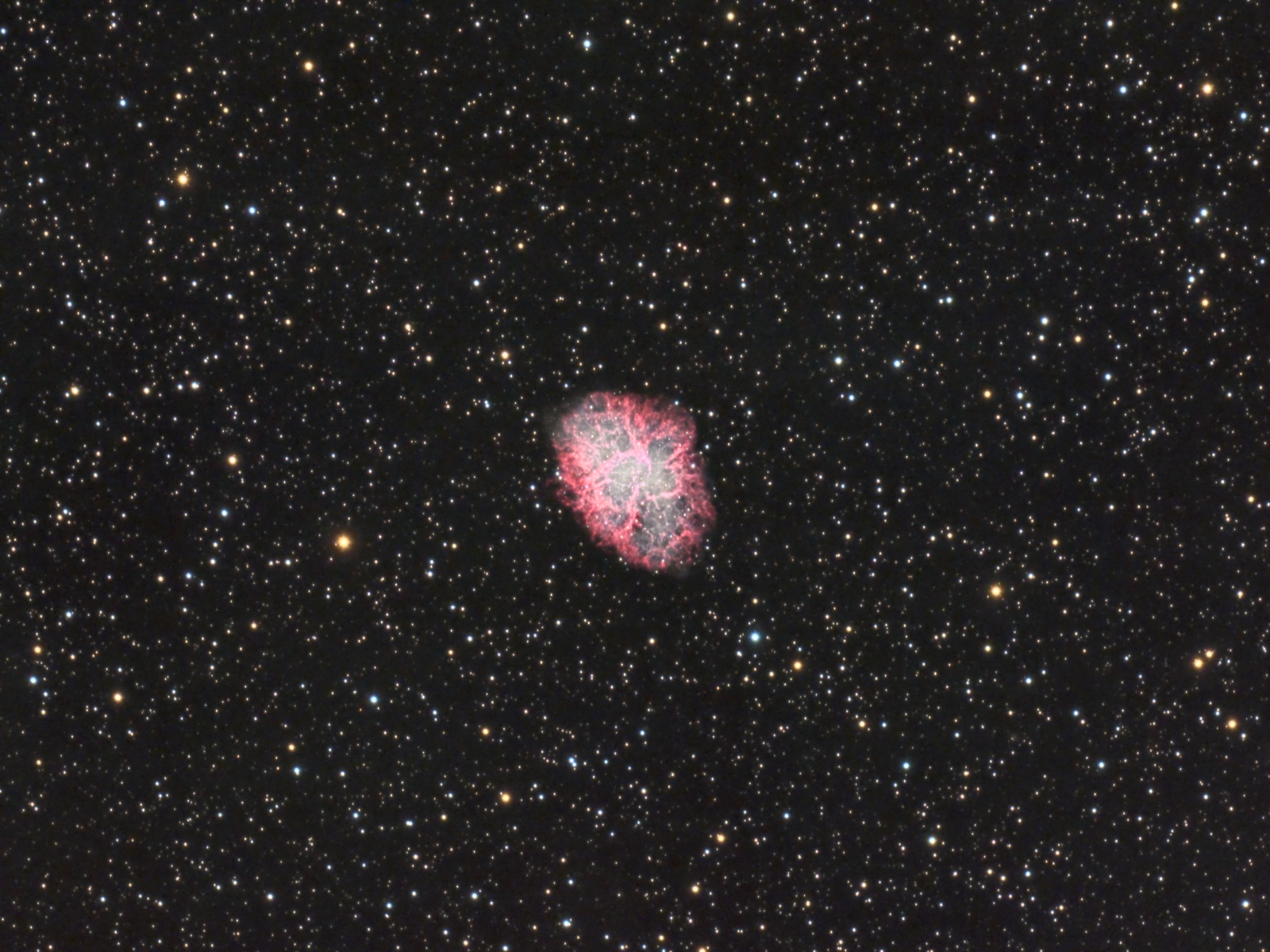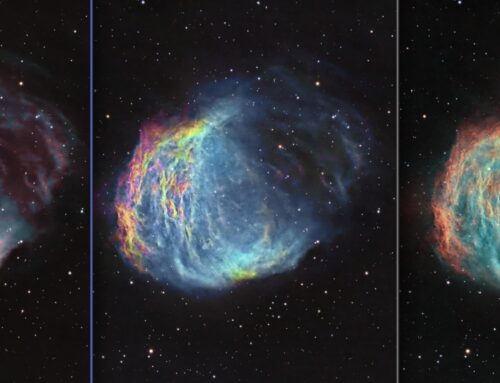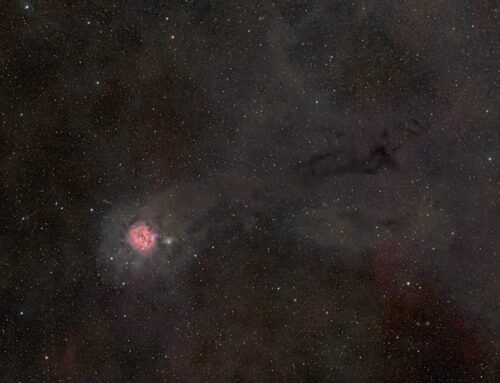M1, The Crab Nebula
 Click image for full size version
Click image for full size version
October 27, 2020
The Crab Nebula is a remnant of a supernova caused by the explosion of a massive star about 6,500 light years away in Taurus, the Bull. The progenitor star exploded in July 1054 A.D., and was seen and documented by people around the world. It was visible during the day for 3 weeks. The nebula is powered by the dense core left over from the explosion, a neutron star. The tiny, massive star spins more than 30 times per second, and appears to emit pulses of gamma rays, so is known as a pulsar. It is the strongest persistent source of X-rays and gamma rays over 30 kEV. We are lucky to get to see it: objects like this dissipate and fade out of visibility gradually over time.
Tekkies:
Acquisition, focusing, guiding and control of Paramount MX mount with TheSkyX. Focus with Optec DirectSync motor and controller. Automation with CCDCommander. Equipment control with PrimaLuce Labs Eagle 3 Pro computer. All pre-processing and processing in PixInsight. Acquired from my SkyShed in Guelph. Average or better transparency and seeing. Data acquired September 26 – October 9, 2020.
Luminance: Sky-Watcher Esprit 150 f/7 refractor and QHY 16200-A camera with Optolong UV/IR and H-alpha filters
Chrominance: Takahashi FSQ-106 ED IV @ f/5 and QHY367C Pro one-shot colour camera with Optolong UV/IR filter
Luminance: 16x10m = 2hr40m
H-alpha: 36x10m = 6hr00m
Chrominance: 61x5m = 5hr5m
Total: 13hr45m
Data Reduction and Initial Processing
Preprocessing: The WeightedBatchPreProcessing script was used to create Luminance and H-alpha master frames (from the mono camera) and a RGB master frame (from the one-shot colour camera).
Gradient Removal: DBE was applied to Luminance, H-alpha and RGB masters using Subtraction.
Colour
Colour Balancing: Colour of the RGB master was balanced with ColorCalibration.
Linear Noise Reduction: MultiscaleLinearTransform was used to reduce noise in the background areas, using an internal mask to protect bright structures. Layer settings for threshold, strength and iterations were as follows: Layer 1: 5.0 0.85, 1 iteration; Layer 2: 3.5 0.75, 1 iteration, Layer 3: 2.0, 0.5, 1 iteration.
Stretching: HistogramTransformation was applied to make a pleasing, bright image, with background set to an intensity of approximately 0.10.
Luminance
Deconvolution: A star mask was made from the Luminance master to use as a Local Deringing Support Image. A copy of the image was stretched to use as a range mask. Deconvolution was applied (100 iterations, regularized Richardson-Lucy, external PSF made using the PSFImage script; Global dark deringing = 0.03).
Linear Noise Reduction: MultiscaleLinearTransform was used to reduce noise in the background areas of the Luminance-filtered image, using an internal mask to protect bright stars. Layer settings for threshold, strength and iterations: Layer 1: 5.0 0.85, 2 iteration; Layer 2: 3.0, 0.75, 1 iteration; Layer 3: 1.5, 0.25, 1 iteration.
Stretching: HistogramTransformation was applied to make a pleasing, bright image, with background set to an intensity of approximately 0.10.
H-alpha
Deconvolution: A star mask was made from the H-alpha master to use as a Local Deringing Support Image. A copy of the image was stretched to use as a range mask. Deconvolution was applied (50 iterations, regularized Richardson-Lucy, external PSF made using the PSFImage script; Global dark deringing = 0.02; Global light deringing 0.003).
Linear Noise Reduction: MultiscaleLinearTransform was used to reduce noise in the background areas of the H-alpha image. Layer settings for threshold, strength and iterations: Layer 1: 4.0 0.85, 1 iteration; Layer 2: 3.0, 0.75, 1 iteration; Layer 3: 2.0, 0.25, 1 iteration.
Stretching: HistogramTransformation was applied to the Ha to make a pleasing, bright image, with background set to an intensity of approximately 0.10.
Combining Luminance, Colour and H-Alpha Images
Creation of LRGB: The Luminance was applied to the RGB image using LRGBCombination with default settings.
Creation of HaLRGB: PixelMath was used to add Ha to the LRGB image, using the following expressions for the R, G and B channels:
R: max($T[0], 1.1*Ha)
G: $T[1]
B: iif($T[0]<Ha, $T[2] + 0.05*Ha, $T[2])
Additional Processing
Nonlinear Noise Reduction: TGVDenoise was used in L*a*b* mode to reduce noise with a mask used to target the background areas and protect the stars and nebula (max. 1,000 iterations and convergence selected for both lightness and chrominance).
Contrast Enhancement: LocalHistogramEqualization was applied with a scale of 35 (max contrast 1.5, strength 0.35, 1 iteration), followed by a scale of 50 (max contrast 1.5, strength 0.25, 1 iteration).
Sharpening: MultiscaleLinearTransform was used to sharpen Layers 2 and 3 with strengths of 0.1 and 0.08, respectively. A mask was used to select only bright nebular features for sharpening.
Final Steps: Background, nebula and star brightness, contrast, and colour saturation were adjusted in several iterations using CurvesTransformation with masks as required. ICCProfileTransformation (sRGB IEC61966-2.1; Relative Colorimetric with black point compensation) was applied prior to saving in jpg format.






Leave A Comment